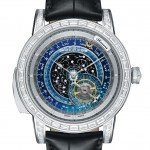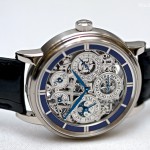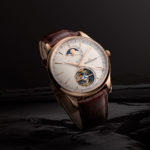Up Close: Jaeger-LeCoultre Master Grande Tradition Répétition Minutes Perpétuelle
Innovative gongs.
Chiming movements – as in a minute repeater or grande sonnerie – have been fairly consistent in construction, being both rare and difficult to master, let alone be improved upon.
But over the past two decades, Jaeger-LeCoultre has developed an impressive number of engineering improvements for its repeating movements, from “trebuchet” hammers that are hinged like the medieval catapult for enhanced striking power, to “crystal” gongs that are welded to the sapphire crystal to boost volume.
This year, the brand has added to its list of striking innovations with revamped, ultra-long gongs in the Master Grande Tradition Répétition Minutes Perpétuelle, which was designed to raise both the quality and quantity of the chimes.

The Grande Tradition Répétition Minutes Perpétuelle with a grained, silver dial
An elaborate case
Available with the dial in either a blue flinqué enamel or a simpler, silvered and grained finish, the Master Grande Tradition Répétition Minutes Perpétuelle (MGTRMP) combines a minute repeater with one of the most user-friendly perpetual calendar mechanisms on the market, plus automatic winding. The self-winding capability is important and practical, because the movement has a short 38-hour power reserve.
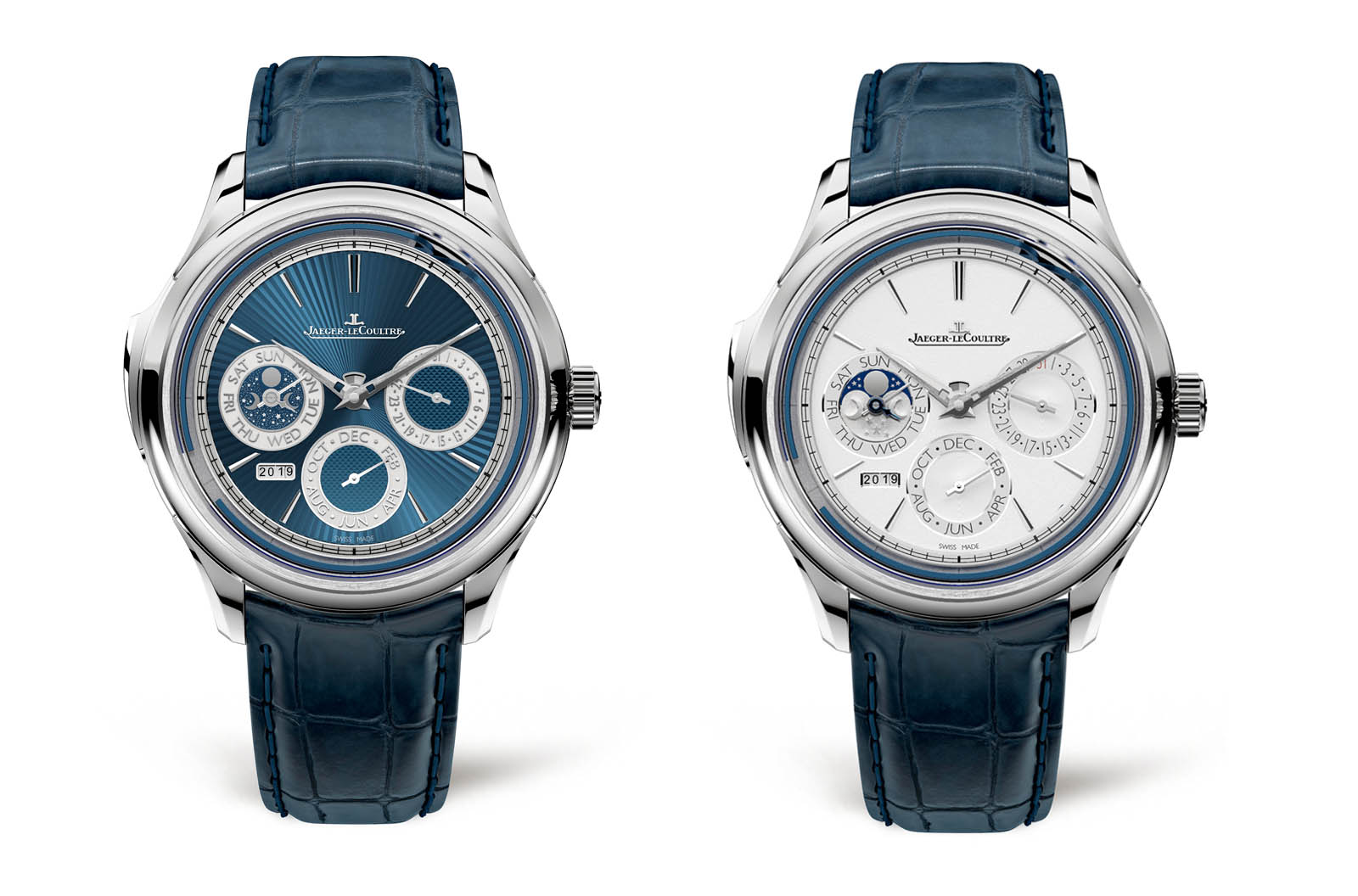
The two dial variants. Image – Jaeger-LeCoultre
All of that is naturally voluminous, and packed into a large white gold case measuring 43mm wide and 13.72mm high.
Though by no means a small watch, it is surprisingly thin for such a grand complication, especially since the movement has a three-level construction, with the automatic winding mechanism sandwiched in between the calendar module and base movement.

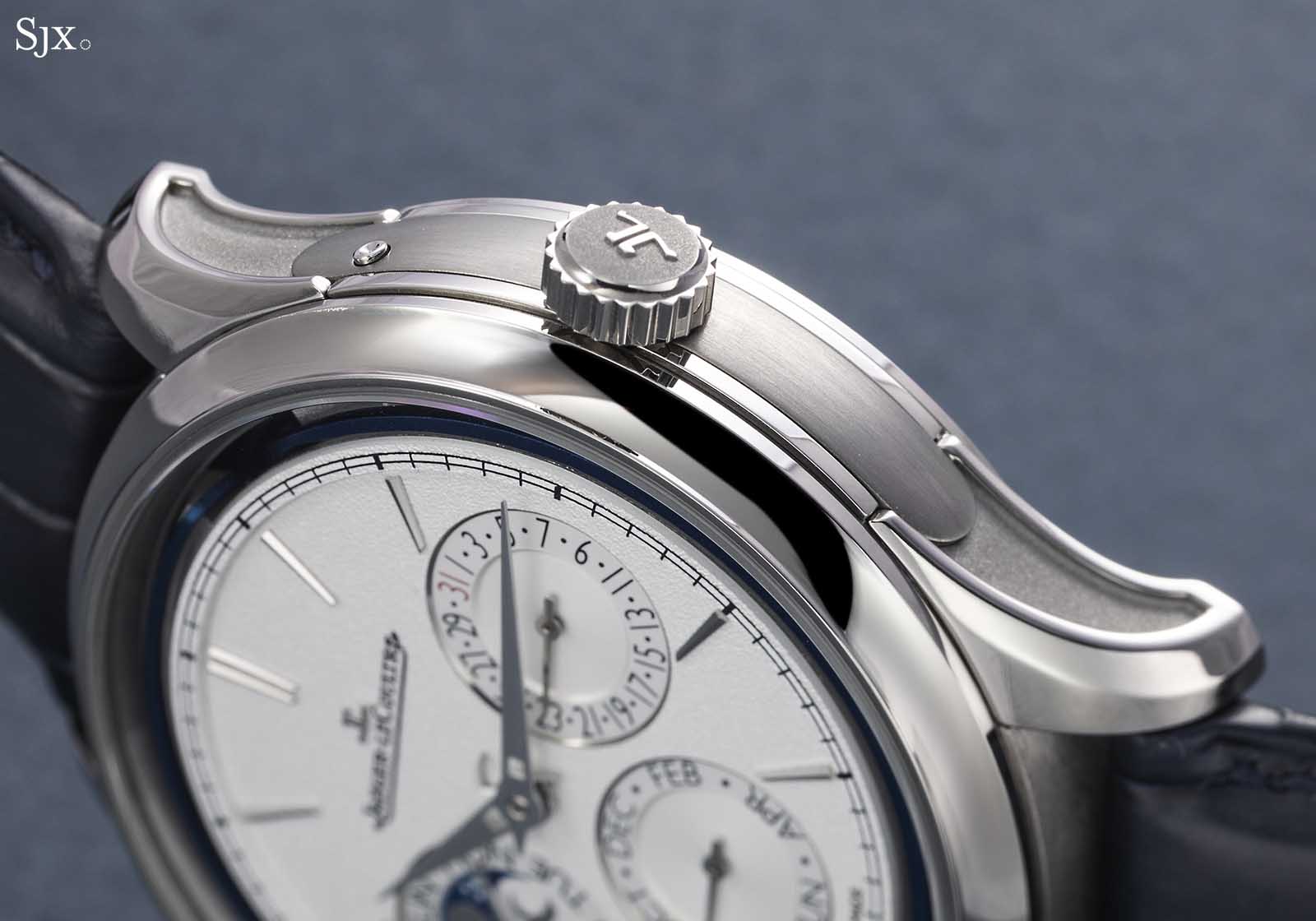
The case is notably elaborate, comprising 80 components, including separate lugs and case band inserts, all finished by hand. It is only the second Jaeger-LeCoultre watch to boast such a case construction, after the Gyrotourbillon Westminster Perpétuel (that costs almost US$900,000). The brand’s other watches, on the other hand, save for the Reverso, utilise a standard three-part construction of bezel, middle and back.
As such, the case lends itself to various contrasting finishes; it is easier to finish individual case components separately. The deeply concave bezel and top surface of the tapered lugs have a polished finish that contrasts particularly well with the grained dial. The recessed sides of the lugs are sandblasted while the case band is satin-brushed. Thus, there are plenty of lines and textures to break up the mass of the case.


The slide of the repeater alone is finished three ways for better definition: a fluted base for better grip, along with a brushed top and polished sides
But there is a downside of having a case made up of many parts – if the tolerances between each part are not minuscule, then the gaps between the parts is visible, as is the case here. The borders between the components, primarily those separating the lugs from the case middle and the inserts from the case flanks, are all obvious.
Repeating innovations
One of the most crucial aspects of a striking movement has to do with how sound is transmitted from the vibrating gongs through the rest of the watch, and then continuing on to the outside of the case.
In a conventional repeater, the gongs are attached to a metal foot attached to the movement base plate, with the two gongs each circling the movement once, but in opposite directions. One gong sounds the treble note while the other a deeper, bass note. The three time indications – hours, quarters and minutes – are in turn derived from this two-note format.
Because the gongs typically occupy the circumference of the movement at the base, sound has to travel through the movement, dial and crystal, as well as laterally through the case band, in order to reach the outside of the watch case.
To boost the volume of the chimes, Jaeger-LeCoultre introduced “crystal” gongs in 2005 in the Master Minute Repeater, where the gongs were attached to a layer of metal deposited on the underside of the front crystal. This allows the sound energy from the gongs to transfer directly to the crystal unhindered, which in turn acts as a more efficient resonator to broadcast the chimes to the outside of the case.

A variant of the original Master Minute Repeater, in titanium and unveiled 2011, which had a skeleton dial revealing the striking mechanism

The crystal gongs were attached to the crystal just below the plate with the musical notes at lower right
And because the gongs are located at the top of the case, the Master Minute Repeater was the first repeater with water-resistant case – rated to 50m no less – since the case could be sealed against moisture, with sound transmitted via the crystal.
It sounds fanciful in theory, but the crystal gongs did work in practice – the Master Minute Repeater was one of the loudest repeaters on the market at launch, and its descendants today amongst the loudest striking watches today. That being said, the crystal gong was largely geared towards volume of sound – loudness – rather than refinement or melody.
With the cal. 950 in the MGTRMP, Jaeger-LeCoultre is taking things a step further, at least in theory. The cal. 950 features a revamped gong construction, featuring a pair of elongated gongs that span both the circumference and height of the movement – stretching over and around the calibre delivering stronger, more resonant chimes.
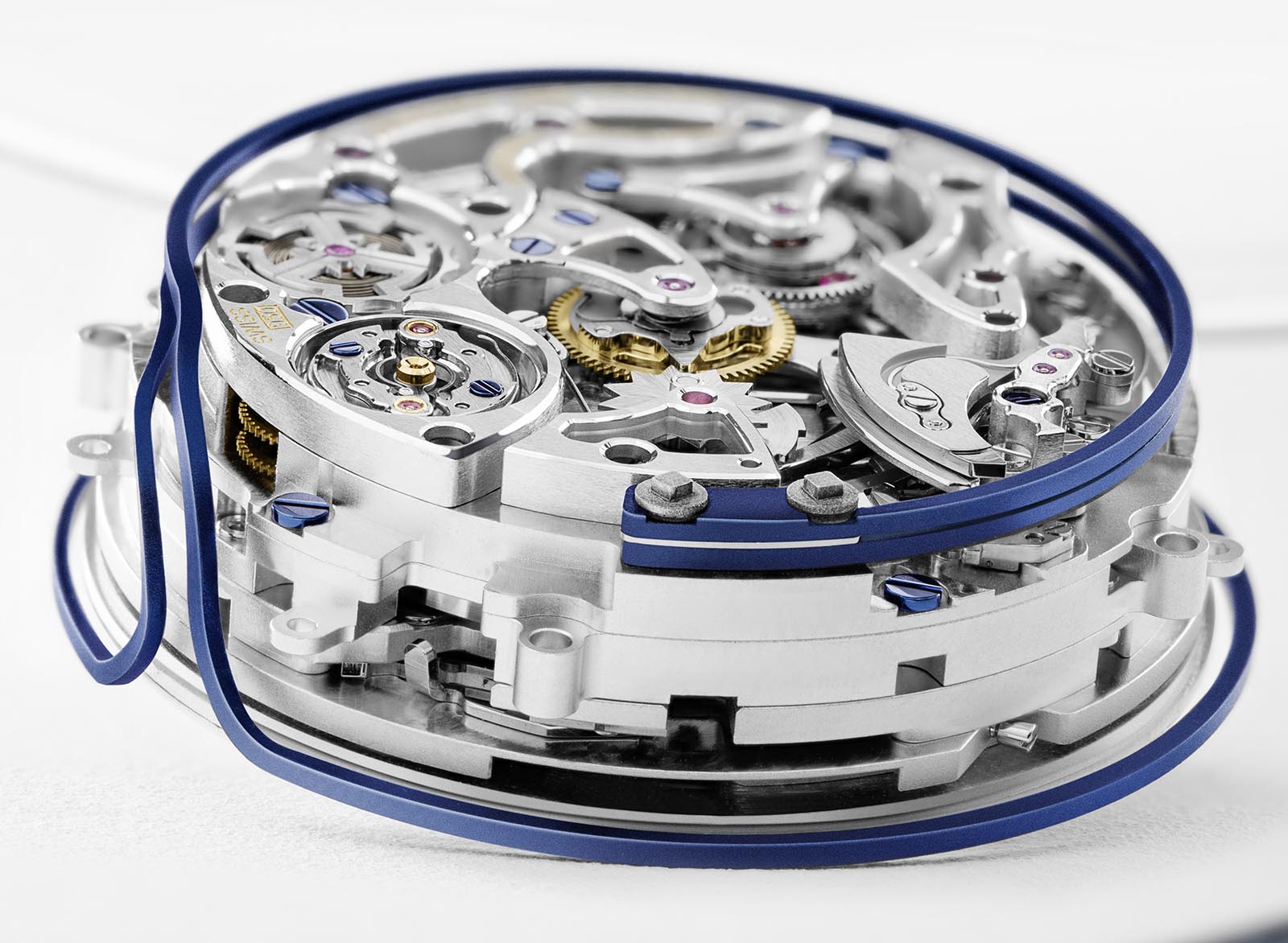
The cal. 950, with the blued gongs prominent around the movement
The new construction is made up of a pair of blued steel gongs welded together at their bases and then attached to the base plate with two screws. From the base, the gongs travel in the same direction, instead of opposite as with traditional gongs, and go on to circle the base of the movement.
But as they nearly complete the circumference of the movement, the gongs arch dramatically upwards towards the dial, and then diverge in opposite directions around the dial, explaining why the blued gongs are visible on both the front and back of the watch.
According to Jaeger-LeCoultre, the elongated gongs amplify the repeater chimes due to the proximity of the gongs to the surface of the case, avoiding the various cams, levers, wheels and governor that would other damper the sound. As such, the watch is rated to 50m as water-proofing the case doesn’t diminish its acoustics.
But it the revamped gongs no doubt also produce more sound because they are longer, with a larger vibrating surface area, much like how larger cymbals produce a greater crash than small ones.
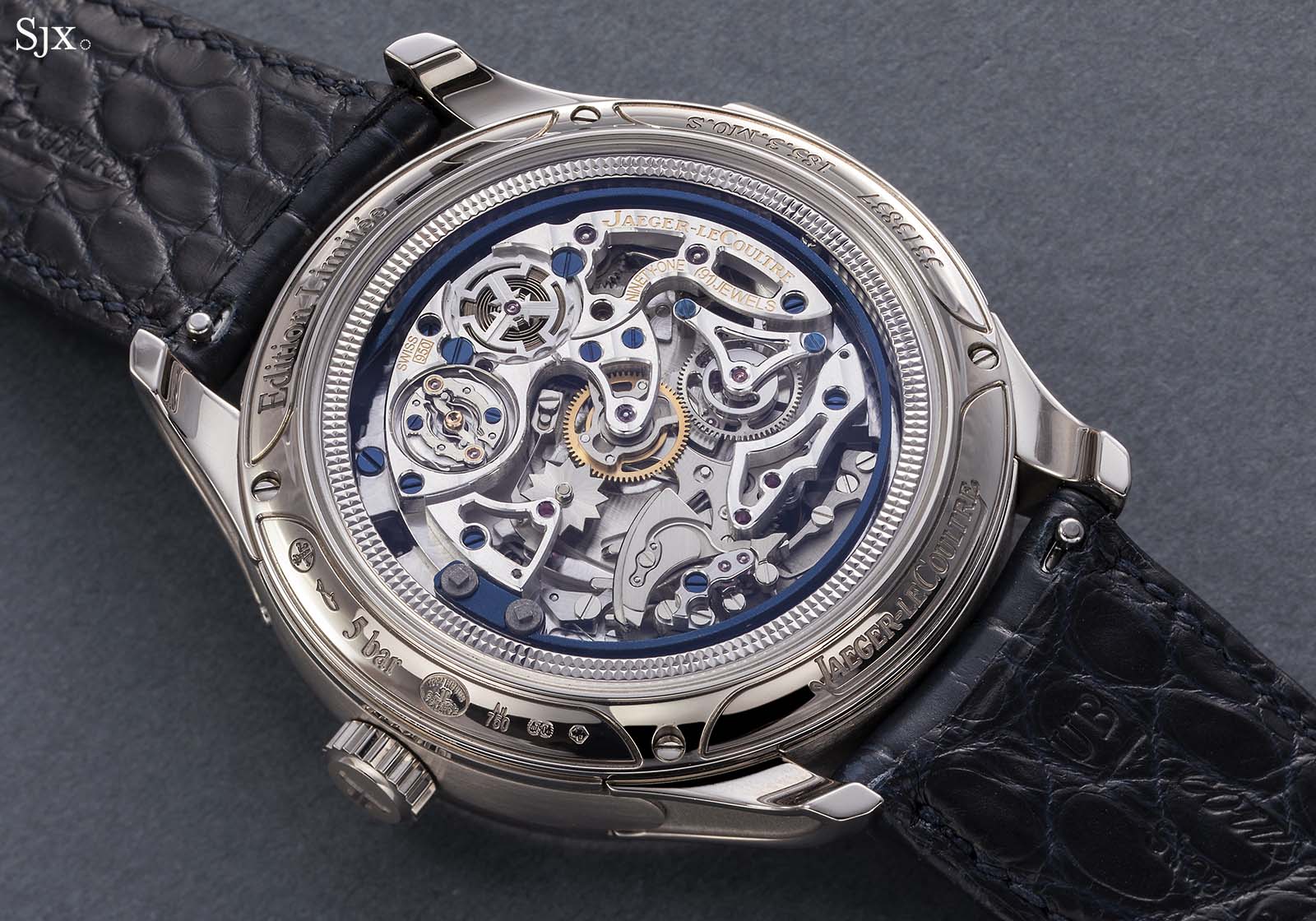
Jaeger-LeCoultre also adds that the new gong construction not only enhances the volume of the chimes, but also the quality, as the unidirectional construction of the bass gong ensures that sound travels in a helical path to produce a more sonorous low note. At the same time, the treble gong switches direction as the gongs curve towards the dial, turning back on itself to produce crisp high notes.
While the gongs are a new invention, the basic architecture of the striking mechanism is identical to that found in the Master Minute Repeater of 2005. The striking module has essentially been mounted on a new base movement, and fitted with the new type of gongs.
Consequently, the repeater does include on two features found on the earlier generation of repeaters. The first is the square, rather than round, cross-section of the gongs, which increases the surface area struck by the flat head of the hammers, since there is full contact of one flat surface against another, creating a deeper and fuller sound.
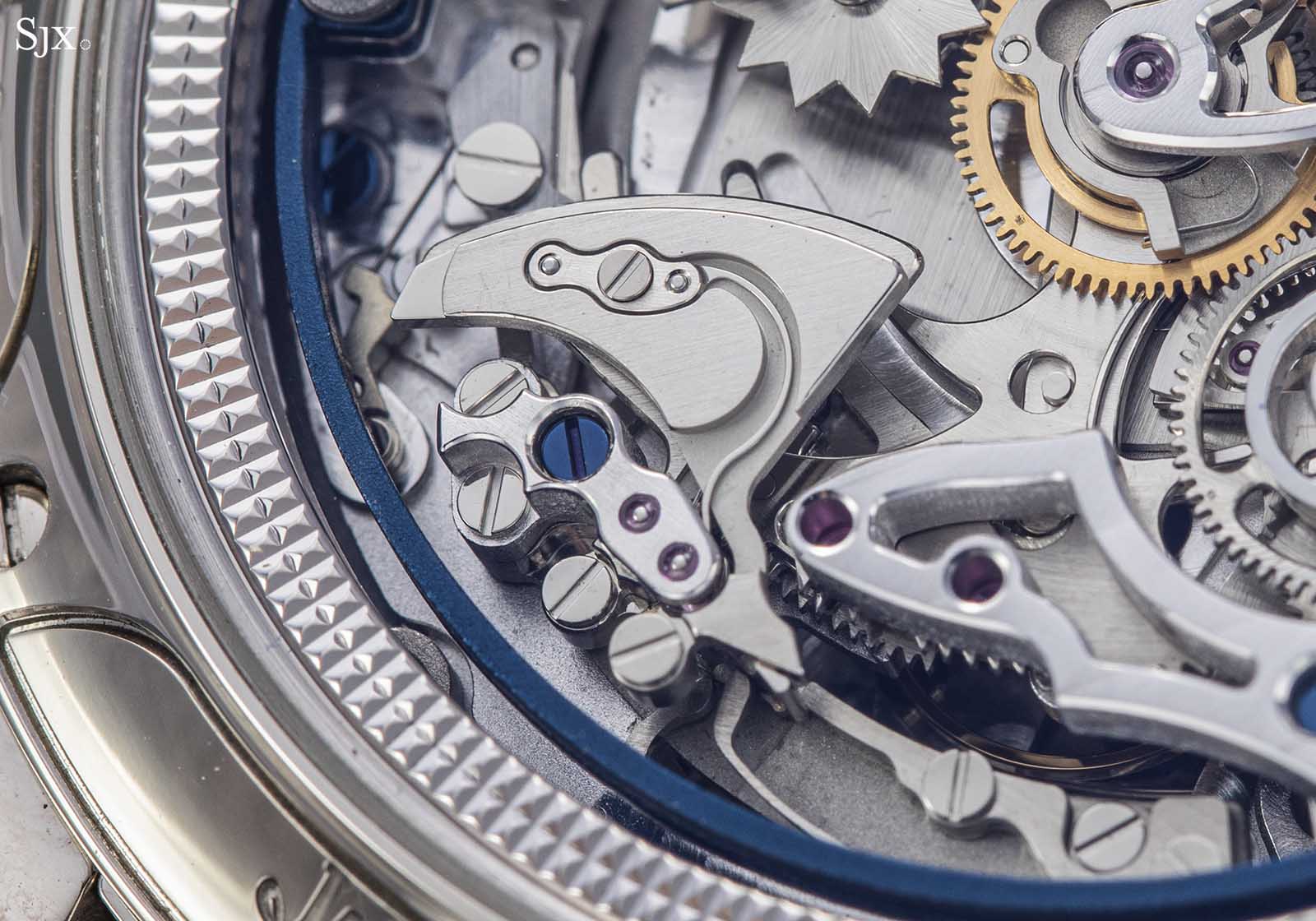
A closeup of the trebuchet hammer with its integrated spring
And the second is are the patented trebuchet hammers first introduced in 2009 with the Hybris Mechanica Grande Sonnerie. Instead of the single pivot of a conventional hammer, the trebuchet hammers have two pivots, just like the medieval catapult, increasing their leverage and power.
And in turn, the trebuchet hammers allow for a smaller striking barrel – the secondary mainspring that powers the repeater – without compromising on the repeater power reserve, as each hammer incorporates a tiny spring on its second axis.
In short, the combination of the unique solutions creates fine chiming watch that is both energy-efficient and volume-maximised, as demonstrated in the clip below. As with the crystal gong-equipped watches of before, the repeater here strikes decisively and loudly, but the focus is obviously on volume rather than refinement.
While the cal. 950 combines every single Jaeger-LeCoultre chiming innovation in a single movement, the performance gain from all of that is hard to discern. Compared to earlier generations of Jaeger-LeCoultre repeaters, including the Master Minute Repeater from 15 years ago, the new grand complication does not seem to be appreciably louder, though it is no doubt a lot more complicated, which is sometimes an end in itself.
Perpetual calendar
On top of all of that, the watch also features a perpetual calendar with a pre-synchronised calendar adjusted via a single pusher embedded in the case side, as well as a distinctive, four-digit year display.
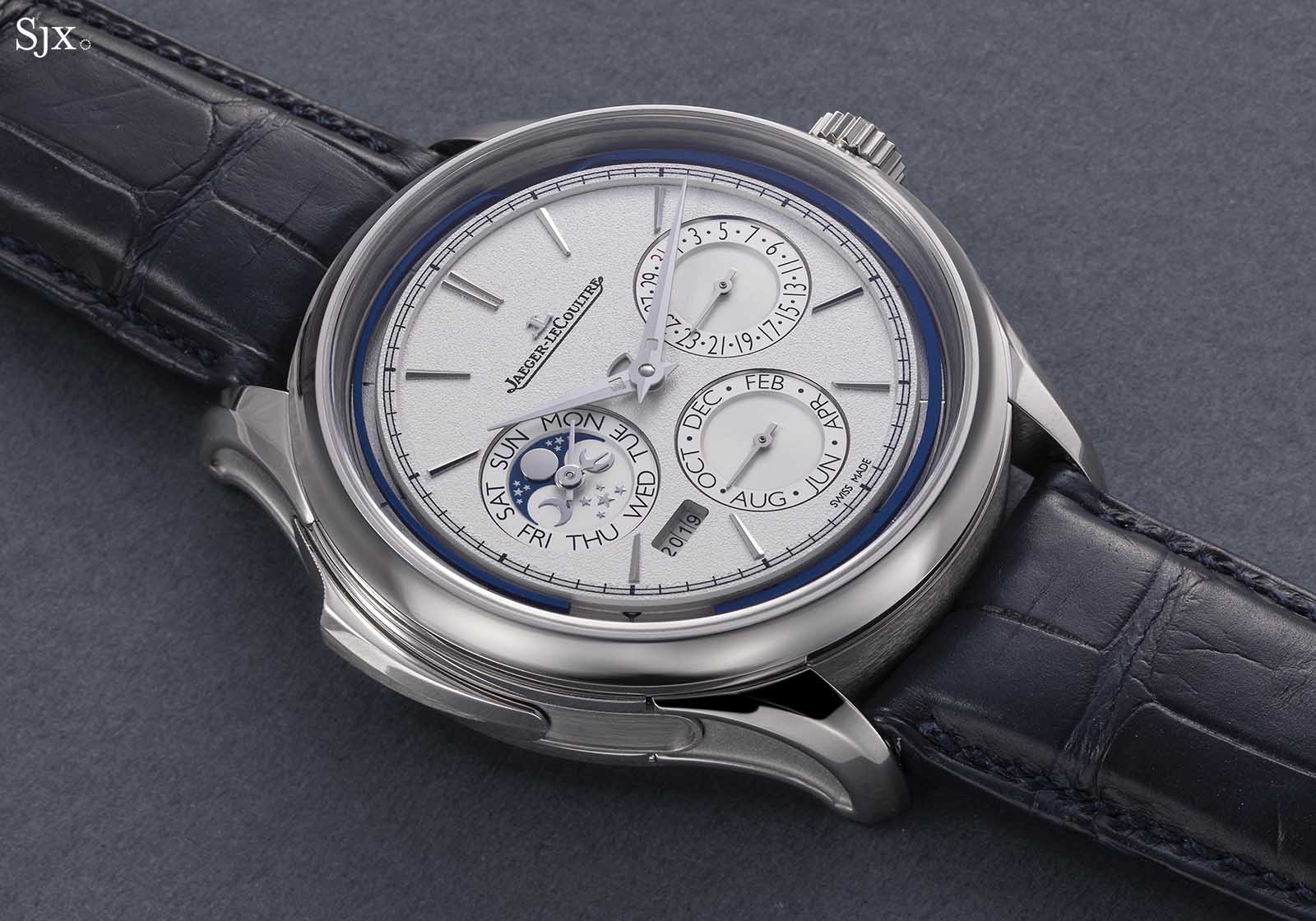
If that sounds familiar, it’s because the calendar module is a simplified version of the trademark perpetual calendar mechanism of IWC, which was invented by Kurt Klaus and introduced in the Da Vinci in 1985. Despite being over 30 years old, the IWC perpetual calendar remains one of the most user-friendly on the market, surpassed only by the Ulysse Nardin Perpetual Ludwig and the minimalist H. Moser & Cie. perpetual calendar.
Everything on the IWC calendar mechanism is pre-set at the factory during production, so the wearer only needs to advance the calendar when necessary. But that convenience comes with a caveat: the calendar can only be set forwards, so if it is set past the current date, the owner needs to wait for the date to catch up. If it is set too far past the current date, a trip to the factory or service centre is needed to return it to the correct setting.
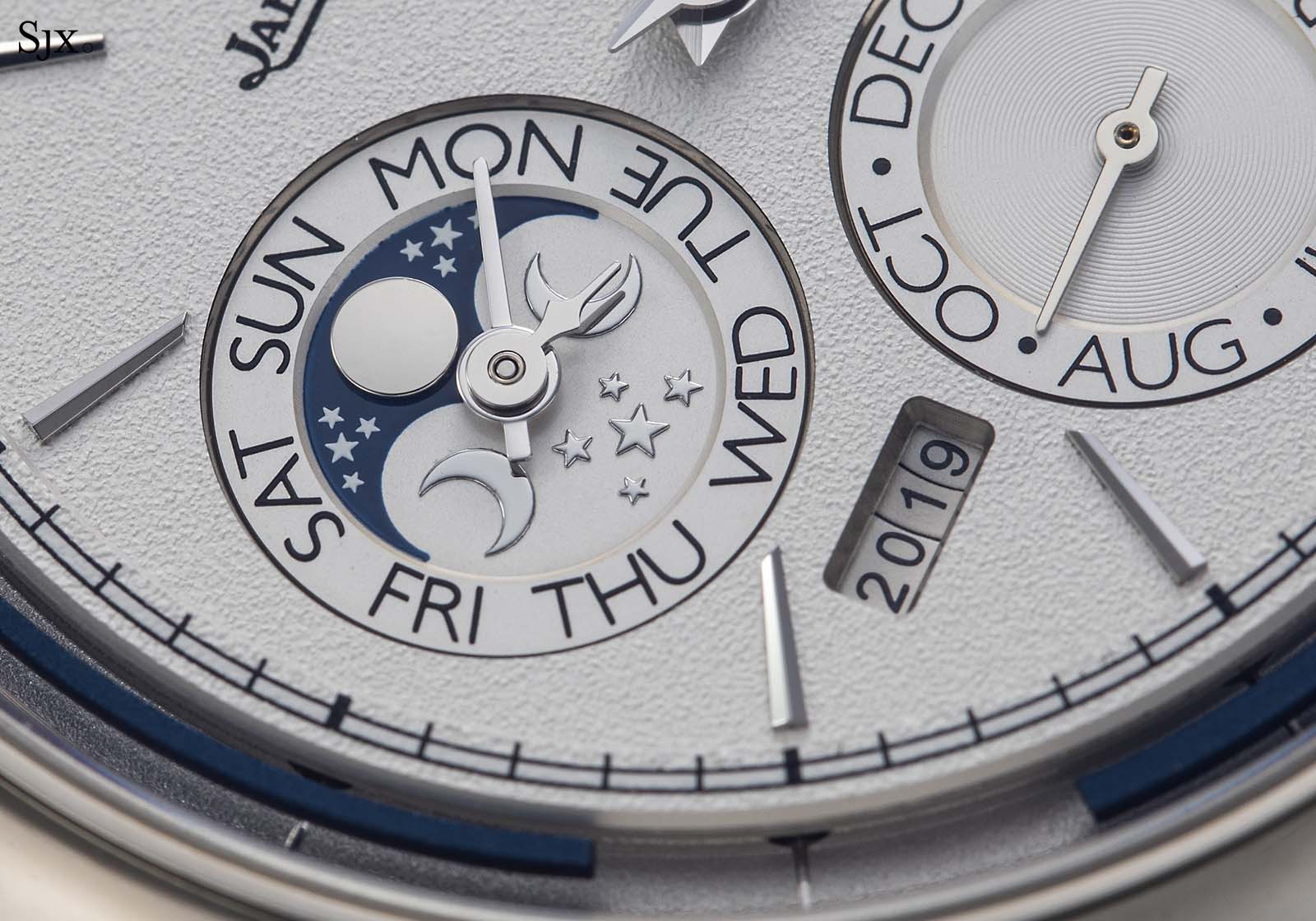
The four-digit year display that quickly identifies the IWC roots of the calendar
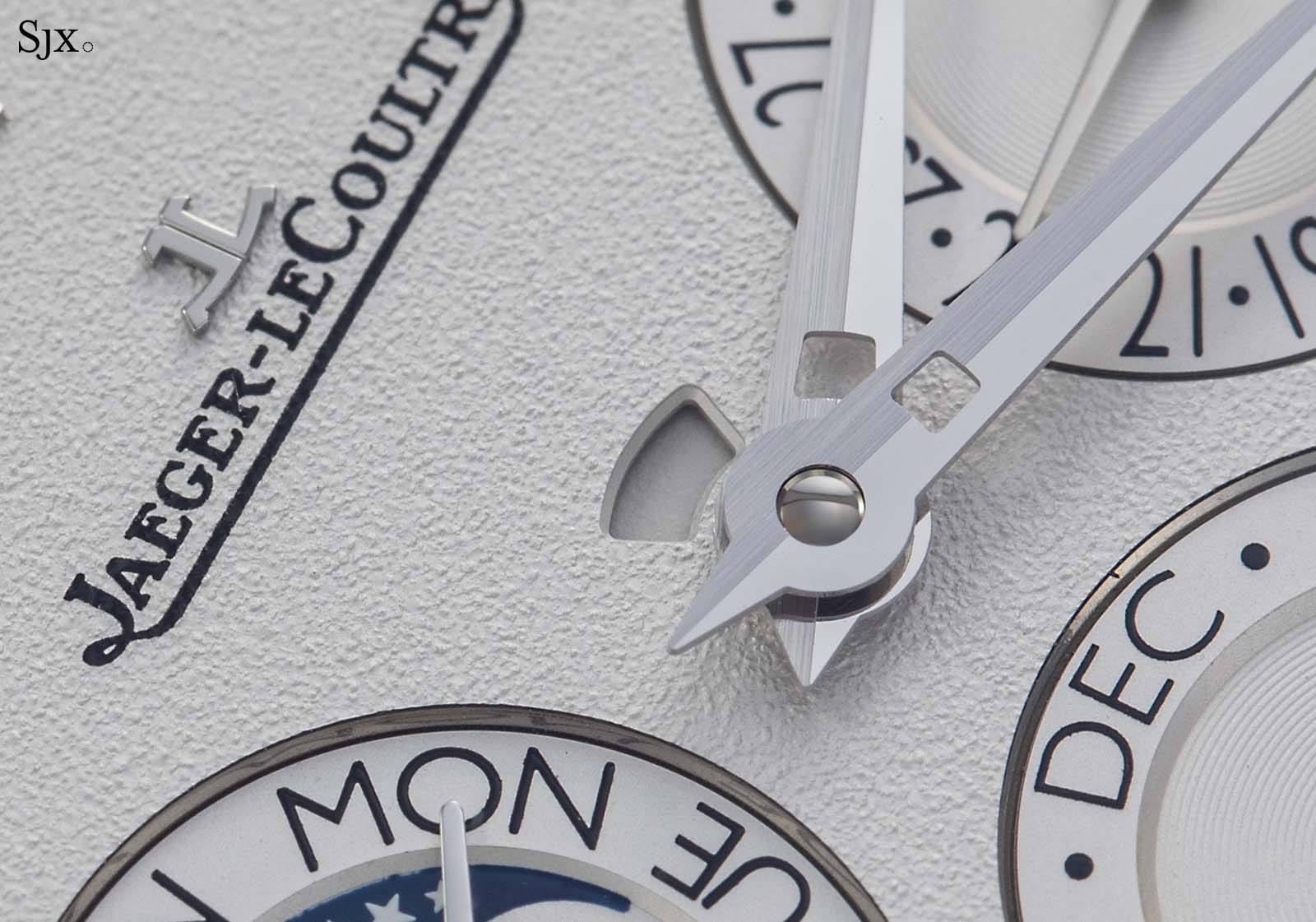
The hour and minute hands are dauphine shaped, with a polished finish on one half and a brushed surface on the other for better legibility. And just above the hands is a small aperture that’s a safety indicator, showing red during the calendar changeover, reminding the owner not to set the time
Despite all of the complexity of the watch, the dial is pretty fuss free, and a bit plain. All its elements are clearly laid out and in a conventional manner. The silver dial does lack contrast, however, with almost all of it being a tone of silver or white. On that count, the blue enamel dial version does better.
The final aesthetic detail worth mentioning is a consequence of the new gong construction: because the gongs circle the dial, and also require clearance under the crystal, the dial sits relatively deep in the case. That leaves a gap between the dial and bezel, with the inside edge of the bezel sloping steeply towards the dial. The result is a slight impression of looking down a tunnel; at a glance, the dial seems further back in the case than it actually is.

Interior decor
Unusually for a grand complication like this, the MGTRMP is automatic, equipped with a cleverly hidden automatic winding. The rotor of the cal. 950 sits under the perpetual calendar module, instead of being on the back as is convention. Instead, the minute repeating module occupies the space on the back, and can be admired in its entirety.

The finishing of the movement is typical of Jaeger-LeCoultre, clean, attractive, and dressed in striking colours with blued steel screws, rhodium-plated brides and several gilded parts.
The edges of the bridges are bevelled and polished, while the top surfaces are finished with either Geneva stripes or straight graining. But perhaps the most attractive aspect of all is the elaborately decorated governor; the complex shape of the governor’s arms are finished with anglage.
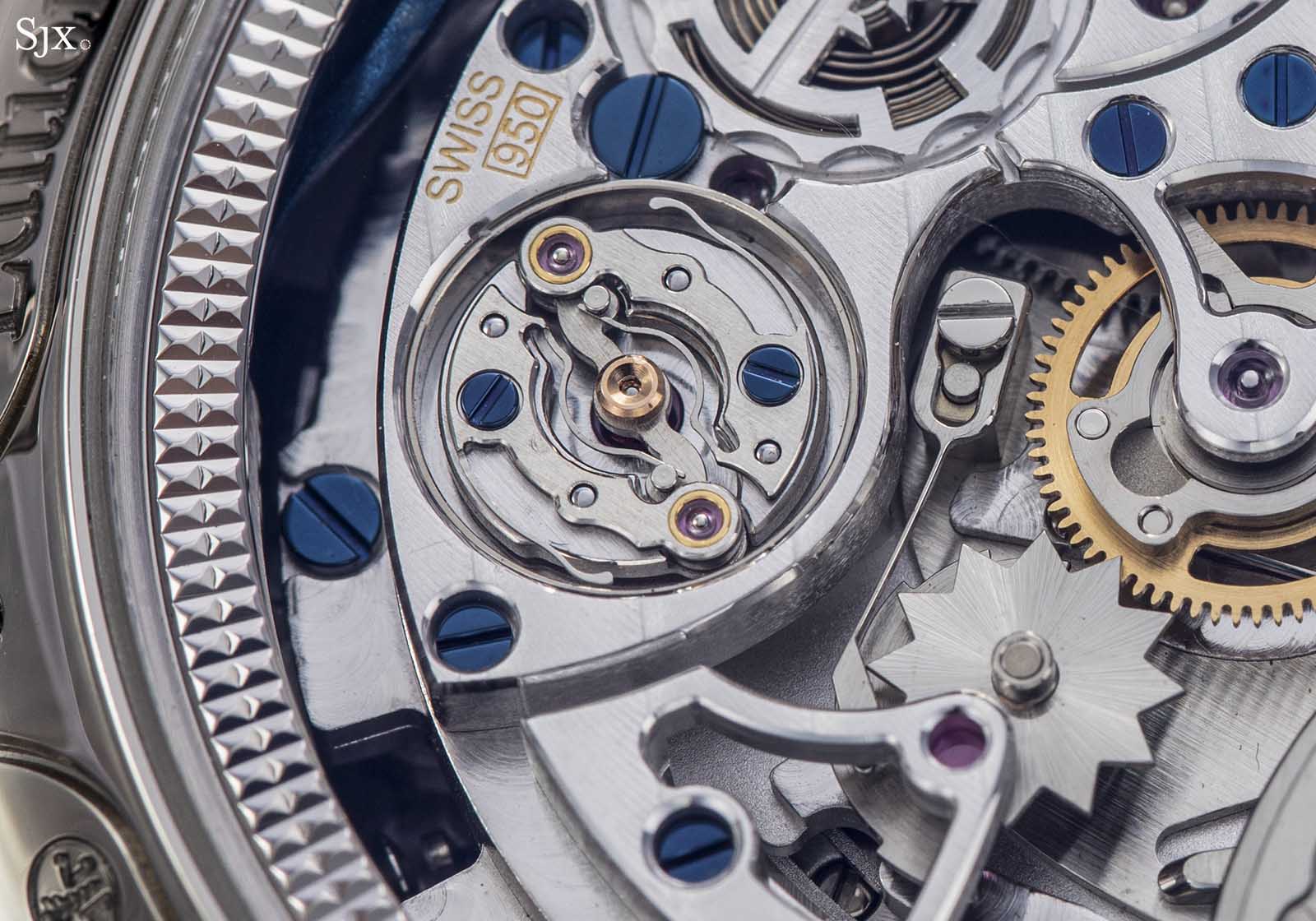

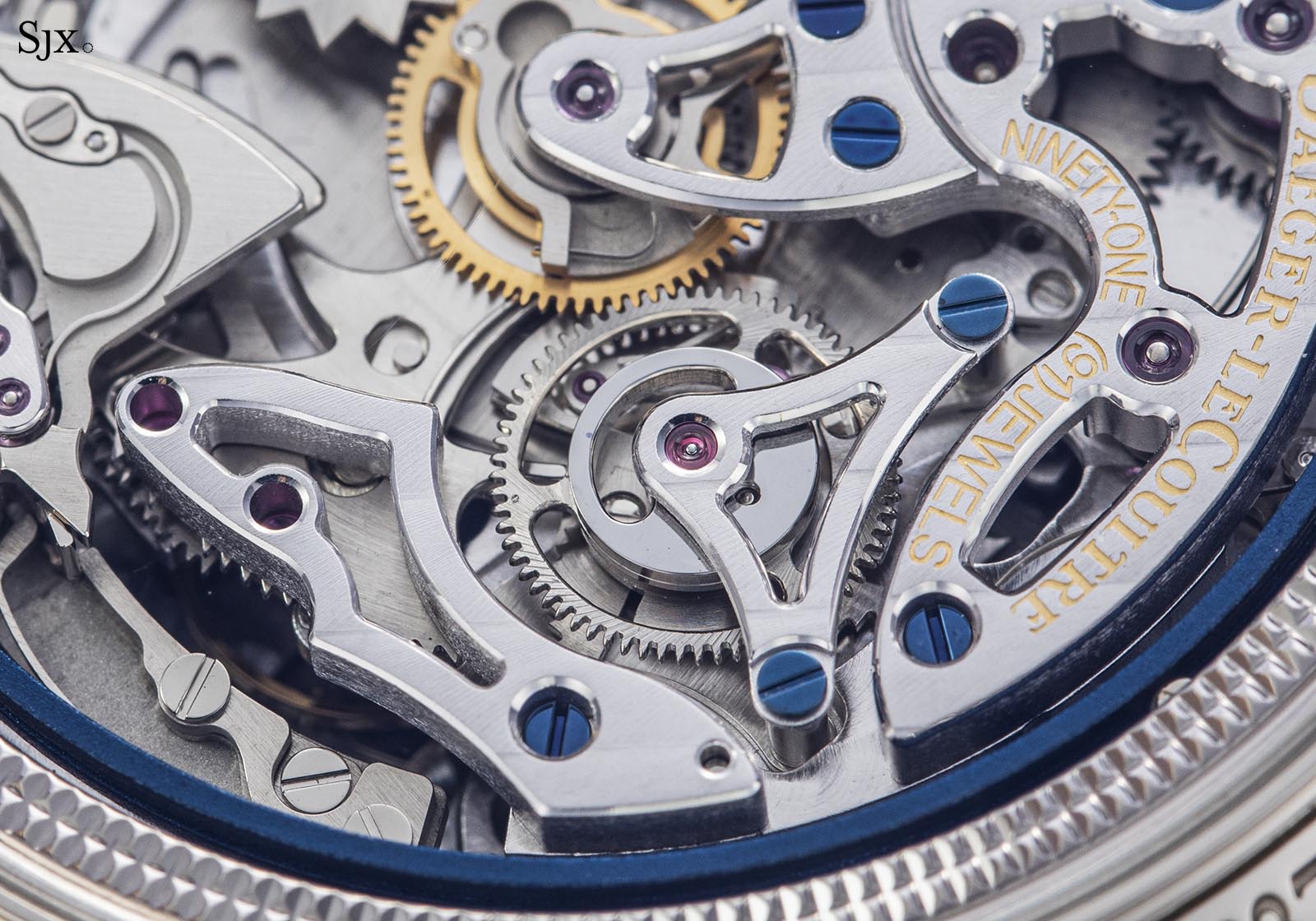
Though the finishing is mostly done with machine or hand-controlled machines, rather than by hand as is the case for the top tier of haute horlogerie movements, it is appropriate given the price and positioning of Jaeger-LeCoultre, which has always prided itself on novel technical solutions and more accessible pricing in all segments.
That being said, one can’t help but feel a bit more can be done in terms of decoration, since the MGTRMP is an expensive watch by any measure, even if it is less expensive than comparable watches from brands like Patek Philippe or Vacheron Constantin.
Concluding thoughts
Large, multi-complication watches were all the rage a decade ago, with most of what can be done having already been done. So such watches no longer shock and awe, particularly since many of the complications within the MGTRMP build on earlier ideas, or are actually earlier ideas.
That being said, the MGTRMP is still an impressive complication, particularly in its engineering and how it amplifies the volume and clarity of the repeater. It is further enhanced by the inventive perpetual calendar, water-resistant case as well as automatic winding, which makes the watch arguably more practical than the average grand complication.
Key Facts and price
Jaeger-LeCoultre Master Grande Tradition Répétition Minutes Perpétuelle
Ref. Q5233420 (silver grained dial)
Ref. Q52334E1 (blue flinqué enamel dial)
Diameter: 43mm
Material: White gold
Water resistance: 50m
Movement: Cal. 950
Functions: Time, perpetual calendar, and minute repeater
Winding: Automatic
Frequency: 28,800 beats per hour (4Hz)
Power reserve: 38 hours
Limited edition: 30 pieces each
Availability: Already at boutiquesand retailers
Price: €225,000 (ref. Q5233420), and €240,000 (ref. Q52334E1), both excluding taxes
For more, visit Jaeger-lecoultre.com.
Back to top.



